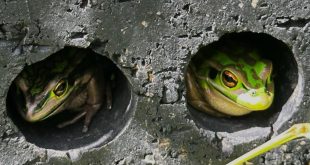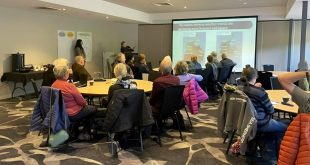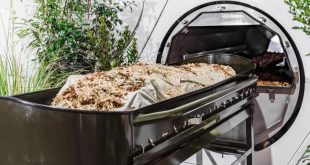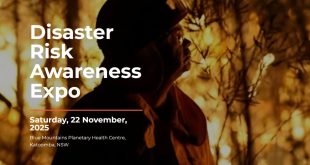
Students using the thermal imaging camera to measure heat differences.
Story and photographs by Louis Wauters
Visiting Belgian medical graduate Louis Wauters reports on the recent visit by medical students from the Rural Clinical School of the University of Notre Dame to the Blue Mountains Planetary Health precinct in Katoomba, and what they learnt about the connection between human health and planetary health.
Key Points:
- The Rural Clinical School of the University of Notre Dame in Lithgow, together with the Blue Mountains Planetary Health Initiative, have been introducing first year medical students to rural medicine, Aboriginal Health and Planetary Health.
- In Australia, heatwaves kill more people than all other natural disasters combined and we need to prepare now in a whole-of-community response to reduce the urban heat island effect and its impact on public health and biodiversity.
- Better water management with increasing green spaces can reduce the heat island effect. The difference between the temperatures of paved areas in full sun and shaded areas under a large tree can be 30C or more on a warm sunny day.
Last week I had the privilege to join the Rural Intensive run by the rural clinical school of the University of Notre Dame in Lithgow. Approximately 150 first year medical students visited the Lithgow and the Blue Mountains region to learn about rural medicine, Aboriginal health and Planetary Health.
During these two days the students experienced a panel discussion about the beauty and challenges of rural health, medical workshops in Lithgow hospital, a snake bite initiation, a guided First Nations tour, and a visit to the Planetary Health Precinct in Katoomba.
The panel discussion highlighted the importance of rural healthcare and its challenges, and provided an opportunity for rural general practitioners and rural emergency doctors to share their stories and their love for working in a rural community.
At the medical workshops I met Georgia Faith, a biology teacher from Lithgow High School. She was attending the rural intensive days with a selection of year 11 and year 12 High School students who had an interest in medicine. Georgia told me: “It is an incredible opportunity to interact with the university and I think the students got a lot out of the experience”.
Louis Wauters talks about the connection between planetary health and preventative medicine, and what drew him to come here to learn more.
The first day ended with a visit to a Lithgow farm to learn about life and health on a farm, infectious diseases that are transmitted from animals, and how to tackle snake bites.

First year medical students experiencing Aboriginal culture
The First Nations guided tour for me was one of the highlights of the two days as I had no previous experience with Aboriginal culture or Aboriginal health. We were welcomed by a guide, Yamandirra, who introduced us to Aboriginal culture.
The tour began with a cleansing ritual and some background information on Country. Afterwards we walked through Katoomba’s beautiful bushland, and we learned about nature, the Mother, and our connection to it.

Students experiencing a guided First Nations tour
Along the trail we encountered plants with antibacterial properties, with enormous vitamin D content, and with amazing scents. The guide told us about the origin of the Three Sisters and through this explained the importance of community and stories in Aboriginal culture. At the end of this tour we made our way to the Planetary Health Precinct.

Professor Lynne Madden from Notre Dame University at the Planetary Health Precinct
During the visit at the Planetary Health Precinct the students first received an introduction to the concept of Planetary Health. This emphasised not only the interconnectedness between the health of humans and a healthy environment, but also the role physicians and the healthcare sector must play in this.
They were taught about heatwaves, which, in Australia, kill more people than all other natural disasters combined, and the need for medical professionals to understand how to reduce the impact of heatwaves on public health.
Saskia Everingham on the experiences of the Notre Dame medical students at the Planetary Health Precinct in Katoomba.
The Blue Mountains Planetary Health Initiative presentation focused on how public health is impacted by the larger natural and social systems we live within, and how we can all work together to change those systems to get better health outcomes.
It particularly focused on water as one of the most critical natural systems we need to understand so that we can reduce future disaster risk. It talked about the need to store water in vegetation, soil and underground to moderate the climate and reduce the severity of climate change impacts.
It was interesting to hear how the more water there is in a substance the cooler it will be in summer and the warmer it will be in winter. For example, grass is much cooler in summer (and warmer in winter) than woodchip, pavers or astroturf!
It emphasised the need to reduce evaporation to keep water ‘on earth’ so that it can support more life. Increased evaporation, especially during heatwaves, also adds to humidity and increases the greenhouse effect. The Planetary Health Initiative presentation also highlighted the importance of collaboration between GPs, local government and community to reduce the risk of disasters and improve public health. Doctors around the world are now prescribing ‘nature’ and ‘social connection’ to improve both mental and physical health and local governments provide many such opportunities, with activities like Bushcare and arts and cultural programs and access to communal spaces like libraries and cultural centres.
It also showcased how its Neighbourhood Local News initiative was connecting communities, and sharing solutions and inspiring stories to grow a more hopeful future.
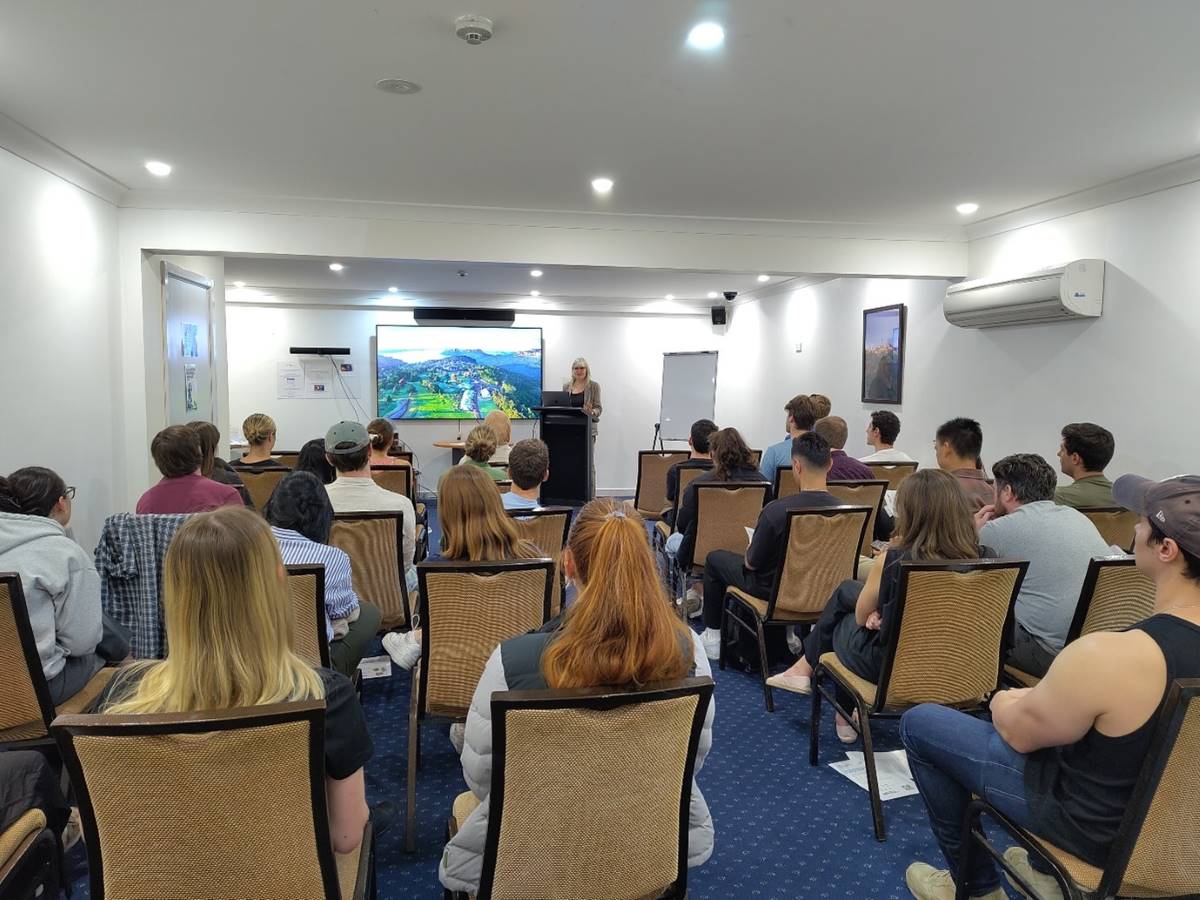
Lis Bastian from the Planetary Health Initiative speaking to one of four groups of students.
Afterwards the students were divided into groups to get hands-on experience in designing spaces to reduce the heat island effect. Each group used a thermal imaging camera to measure the surface heat of different objects and materials. The sunny conditions were ideal to measure the different temperatures of areas in shade or full sun, and of pavement and asphalt, tiles, astroturf, mulch, grass, trees and other vegetation.

Students using the thermal imaging camera to measure heat differences.
The students then discussed their observations and remarked on the temperature differences: even between light and dark coloured surfaces. The importance of shade and the benefits of natural shade, which is cooler, versus man-made shade, was particularly obvious. It wasn’t a very hot day, but the students were surprised to see that there was a 30C difference between the shade under a large tree and a paved area in full sun. They also discussed the need for ventilation, both mechanical and natural.
Most students didn’t know about Planetary Health or had only been briefly introduced to it in an assignment. They were visibly interested and were thankful for the experience and the lessons they learned. As Kiaro said, “I thought it was really important, what they touched upon, how everyone can contribute to daily life”.
So many of the activities of the two days were memorable but what mostly stayed with me was the sense of community I experienced at the rural clinic in Lithgow. To see how the professors, lecturers, students, staff, even the Head of the Rural School, all worked together was heartwarming.
Everyone came together in a spirit of camaraderie to share knowledge and experience with a new generation. This for me seemed the biggest strength of a rural setting for a physician. There was a true sense of community; of being welcomed and feeling at home: even for someone from the other side of the planet.
